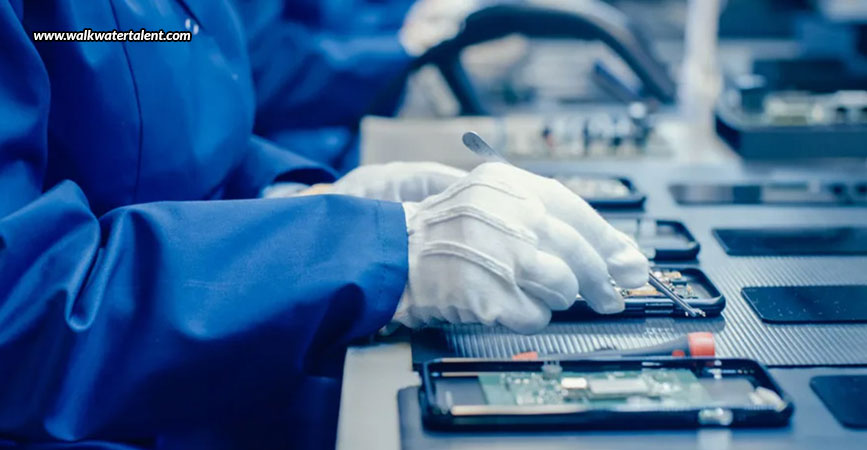
At WalkWater, since October, we have been tracking the Atmanirbhar Bharat campaign through a series of articles about those sectors which could see a lot of activity in executive hiring in the coming few years in India. The first two articles in this series covered the Defence Manufacturing and Pharmaceuticals sectors. This article explores the potential of the Electronics Manufacturing Sector in India. In our view, this sector has the brightest prospects for helping India take centre stage in the world economy. This article tries to understand the reasons for the same.
Electronics
After the recent announcement of Performance Linked Incentive (PLI) scheme for India’s electronics manufacturing sector, the country has already received fresh investment proposals worth INR 12 lakh crores from some of the the largest Indian and global OEM and EMS players including Samsung, Micromax, WInstron, Foxconn, Dixon etc. In a more recent development, the Tata group of companies is seeking overseas loans of up to $1B to set up a phone plant in Tamil Nadu. Also, there was news in December that the Korean giant Samsung seems to be firming up plans to shift one of their units out from China to India. Clearly investment action is hotting up in this sector.

The emerging global geopolitical realignment is another factor that could work in India’s favor. The relentless standoff between the UK and USA on one side, and Chinese company Huawei on the other, make it clear that mobile telephony is today an important part of espionage and national security, and not limited to communication alone. The general feeling of antipathy of the world towards China following the outbreak of the pandemic has been another strong factor in many electronics giants rethinking their manufacturing dependence on China and considering alternative locations like India, amongst others. Around the world, governments and companies have been actively considering ‘reshoring’ some parts of their global value chains to their own countries or to alternative low cost manufacturing destinations, and the pandemic has acted as a shot in the arm for these efforts. India looks to be strongly placed as a global low cost manufacturing destination.
Apart from these external factors, India itself provides a very strong reason for global electronics manufacturers to have some part of their manufacturing or assembly operations in India. India is the second largest user of mobile phones, fourth largest user of televisions, third largest producer of solar energy, just to name a few. The sheer volume of aspirational consumers with impressive spending power makes India a very attractive destination for electronics manufacturers. As per Statista, there were almost 450 million mobile phone internet users in India in 2020, and this number is expected to go up to 500 million in the next three years. Given India is such a vast market for mobile phones and many white goods, most companies around the world are keen to have a slice of the pie.
But all this good news comes with a caveat. Our manufacturing expertise in mobile phones is actually limited to manual semi knocked down (SKD) level assembly of mobile phones and their accessories. A large number of the spare parts of these semi knocked down kits comes from different countries like the USA, Taiwan, South Korea, and even China. There are several reasons for this. Let us take semiconductor chips, for instance, which are at the core of all the circuit boards used in every electronic gadget. India has done well in design and verification for the semiconductor industry, with most of the global semiconductor companies having an R&D footprint in India, but 100% of our chips, memory and display are imported into the country. In India we are not yet able to manufacture panels that can match the quality of those that Samsung and other manufacturers use in their smartphones. There are many other such stumbling blocks which have ensured that we are still assemblers of smartphones, and not manufacturers.
 In the context of the assembling versus manufacturing debate, it is also important to discuss Electronics Manufacturing Services (EMS). As we come to the end of 2020, the positive sentiment about EMS in India continues. In November, Dixon Technologies stock zoomed 290% up from its March levels. This 26 year old homegrown Indian giant began by manufacturing televisions, then moved on to color televisions, metal sheets and mouldings, washing machines, before beginning mobile phone manufacturing in 2016. On the other hand, Sanmina is a US company whose Chennai factory has EMS capabilities outside of mobile handsets, and manufactures medical equipment, storage & computing, avionics, industrial and multimedia solutions. Flextronics is a global major in automotive and healthcare EMS and has manufacturing facilities in 3 locations in India – Pune, Bengaluru, and Chennai. These are just 3 examples from the exciting roster of companies that make up the EMS landscape for India, who are expected to take advantage of the PLI announcement along with new players.
In the context of the assembling versus manufacturing debate, it is also important to discuss Electronics Manufacturing Services (EMS). As we come to the end of 2020, the positive sentiment about EMS in India continues. In November, Dixon Technologies stock zoomed 290% up from its March levels. This 26 year old homegrown Indian giant began by manufacturing televisions, then moved on to color televisions, metal sheets and mouldings, washing machines, before beginning mobile phone manufacturing in 2016. On the other hand, Sanmina is a US company whose Chennai factory has EMS capabilities outside of mobile handsets, and manufactures medical equipment, storage & computing, avionics, industrial and multimedia solutions. Flextronics is a global major in automotive and healthcare EMS and has manufacturing facilities in 3 locations in India – Pune, Bengaluru, and Chennai. These are just 3 examples from the exciting roster of companies that make up the EMS landscape for India, who are expected to take advantage of the PLI announcement along with new players.
To give a further filip to the electronics sector, The government has also approved proposals to set up electronics manufacturing clusters in as many as 20 locations across the country. Here is an indicative list of the other facets of the umbrella term ‘Electronics’ that would be covered through these 20 clusters
- IT hardware
- Set top boxes
- Televisions
- Electronics manufacturing
- Automotive electronics
- IoT and network products
- Power electronics
- Electronics consumables, components, and accessories
- Point of Sale (POS) systems
So what impact do all these developments have on hiring? At the outset, all manufacturing companies in general, and the electronics manufacturing sector in particular, have learnt many lessons in 2020 the hard way. As the bullwhip effect in India’s automobile sector has shown us since 2019, small disruptions at any one end of the supply chain can cause progressively larger disruptions in the other components of the supply chain. So as retail demand fell continuously, many car dealerships and component manufacturing units folded up. Similar horror stories have played out all year in all sectors, including electronics.
What this tells us is that from 2021 onwards, all manufacturers (including electronics manufacturers and EMS companies) will have to put in a lot of effort and expertise in efficient demand forecasting models and supply chain processes. Electronics manufacturers will have to seriously invest in putting robust forecasting models in place, preferably with artificial intelligence capabilities which can trawl through humongous amounts of data and come up with useful insights. This will need them to plan for hiring AI and ML experts who can help those machines and tools do that forecasting efficiently. Further, as India scales up its manufacturing investments, IOT and Industry 4.0 will become key drivers of cost and productivity – the industry will see increased demand for technology leaders like Chief Information Officer, Chief Digital Officer, Chief Analytics Officer apart from continuous need for design, product engineering and marketing roles.
The caveat in the engineering side is that, as discussed above, we are still some way off from having the technological capability to manufacture wafers, lithographs, chips, display panels etc. If India needs to take the next quantum jump for assuming the mantle of global leadership, then all companies would need to attract talent that has experience in core manufacturing and we expect that the industry will increasingly hire expatriate talent with “expert” skills from locations like Taiwan, Korea, USA, Singapore etc.
As we said at the start, the potential for the electronics sector in India goes way beyond the assembling or manufacture of smartphones. If all the areas of the electronics industry that we have covered above perform to their potential, this sector can easily be one of the frontrunners in providing economic activity, employment generation, import substitution and so much more.
About WalkWater Talent Advisors
WalkWater Talent Advisors is among the Top Executive Search Firms in India. Started in 2011 by search industry leaders, we are today a 30 member team across five offices and an enviable track record across industry sectors, both in India as well as globally. The WalkWater team brings a unique mix of strengths – Intensive Client Partnering, Deep Domain Knowledge and Global Coverage, among others. This, coupled with a start-up drive to excel, and a constant focus on values, provides an unparalleled experience to our clients.
WalkWater has an impressive track record across sectors – Technology, Consumer and Retail, Industrial, Pharmaceuticals, Healthcare & Lifesciences, and BFSI. Apart from assisting 350+ companies hire 700+ leaders, WalkWater has also completed 40+ bespoke Talent Advisory engagements for established organizations and startups.
By Rahul Shah,
Co-founder & Director,
Walkwater Talent Advisors








